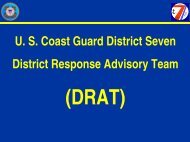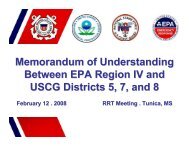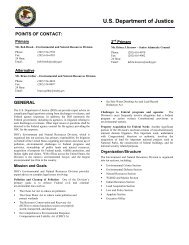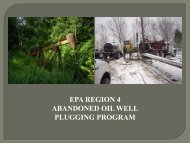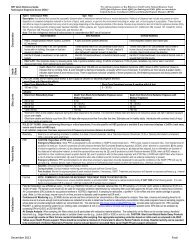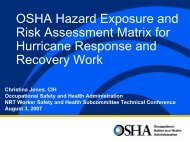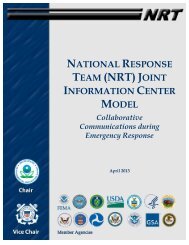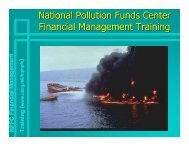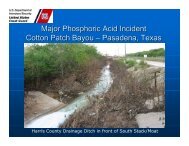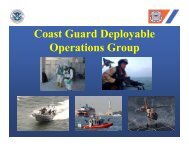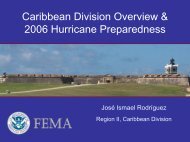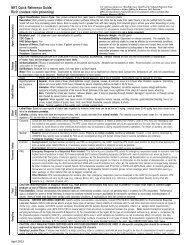USE OF DISPERSANTS - U.S. National Response Team (NRT)
USE OF DISPERSANTS - U.S. National Response Team (NRT)
USE OF DISPERSANTS - U.S. National Response Team (NRT)
- No tags were found...
Create successful ePaper yourself
Turn your PDF publications into a flip-book with our unique Google optimized e-Paper software.
Biological Assessment of Effects on Listed Species of Caribbean Regional <strong>Response</strong> <strong>Team</strong>Letters of Agreement on limited Use of Oil Spill DispersantsDescription of Proposed ActionThe proposed actions are two Caribbean Regional <strong>Response</strong> <strong>Team</strong> (Caribbean RRT/CRRT) Letters of Agreementpre-authorizing limited use of dispersants by the pre-designated United States Coast Guard (USCG) On-SceneCoordinator (OSC) on oil discharges impacting the waters of the Commonwealth of Puerto Rico and the Territory ofthe U.S. Virgin Islands. The Letters of Agreement implement Subpart J of the <strong>National</strong> Oil and HazardousSubstances Contingency Plan (NCP) and are signed by the USCG, U.S. Environmental Protection Agency (<strong>USE</strong>PA),U.S. Department of Interior (USDOI), the U.S. Department of Commerce (USDOC), and the Commonwealth ofPuerto Rico, and the Territory of the U.S. Virgin Islands.The Caribbean RRT agrees that the primary method of controlling discharged oil shall be physical removal for theenvironment. The Caribbean RRT recognizes, however, that in certain instances physical containment, collection,and removal of oil may not be possible and the use of dispersants must be considered in order to prevent substantialthreat to public health or serious environmental damage. By breaking a cohesive surface oil slick into small dropletsthat disperse into the water column, dispersants can prevent an offshore oil spill from contaminating wildlife andcritical habitat in nearshore and shoreline areas.The Caribbean RRT strongly recommends that, to be effective, application of dispersants should be targeted to beginnot later than six hours after an oil spill. Accordingly, employment of dispresants usually requires that authorizationfor use be given prior to a spill incident. Within areas pre-authorized for use of dispersants by the Letters ofAgreement, further consultation by the USCG OSC is not required, provided the appropriate CRRT agencies areimmediately notified and applicable protocols are followed. Pre-authorization allows the USCG OSC to order theuse of dispersants, as defined in the <strong>National</strong> Contingency Plan (NCP) and listed on the <strong>USE</strong>PA NCP ProductSchedule, when in the judgment of the USCG OSC their use is necessary to prevent substantial threat to publichealth or welfare or to minimize serious environmental damage. The Letters of Agreement are not intended toexclude or replace the use of mechanical, in-situ burning, or other open-water cleanup methods but to enable andencourage the use of all appropriate techniques in the strategy to remove oil from the water surface and, thereby,minimize environmental impacts of a spill.If a decision to use dispersants is made, the USCG OSC will immediately notify the <strong>USE</strong>PA, USDOC, USDOI, theCommonwealth of Puerto Rico, and the Territory of the U.S. Virgin Islands through CRRT representatives. A postincidentbriefing will be held within 45 days following an application of dispersants to exchange information oneffectiveness of the application and to determine whether changes to the Letters of Agreement are necessary.Description of Pre-authorization AreaPre-authorization Area for the Commonwealth of Puerto Rico:Dispersants are pre-authorized for use only in open waters that are at least 0.5 nautical miles from any shoreline andwhere the water depth if greater than 60 feet.Dispersants are not pre-authorized for use in, on, or over waters containing reefs, waters designated as marinereserves, mangrove areas, fresh or brackish waters or waters in coastal wetlands; except with the prior and expressconcurrence of the Puerto Rico Department of Natural Resources and <strong>USE</strong>PA, in consultation with USDOC andUSDOI. Coastal wetlands include: submerged algal beds (rocky or unconsolidated bottom), submerged seagrassbeds, and coral reefs.Pre-authorization Area for the Territory of the U.S. Virgin Islands:Use of dispersants is pre-authorized only in open waters that are at least one mile from any shoreline, or at least one



